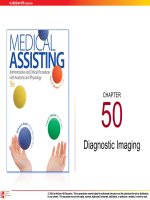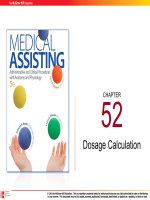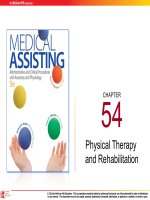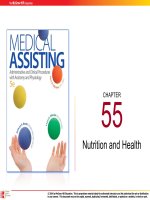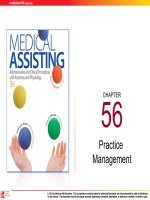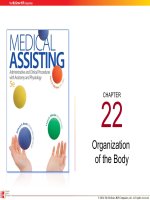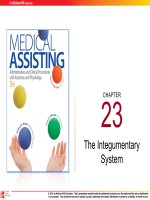Medical assisting Administrative and clinical procedures (5e) Chapter 34 The endocrine system
Bạn đang xem bản rút gọn của tài liệu. Xem và tải ngay bản đầy đủ của tài liệu tại đây (976.91 KB, 42 trang )
CHAPTER
34
The Endocrine
System
34-2
Learning Outcomes (cont.)
34.1 Describe the general functions of hormones
and the endocrine system.
34.2 Identify the hormones released by the
pituitary gland, thyroid gland, parathyroid
glands, adrenal glands, pancreas, and other
hormone-producing organs, and give the
functions of each.
34-3
Learning Outcomes (cont.)
34.3 Explain the effect of stressors on the
body.
34.4 Describe the causes, signs and
symptoms, and treatments of various
disorders.
endocrine
34-4
Introduction
• The endocrine system includes the organs that
secrete hormones
• Hormones
– Regulate chemical reactions in cells
– Control functions of the organs, tissues, and other
cells
to
n
i
Glands
bloodstream
to
secrete
hormones
target tissues
34-5
Hormones
• Endocrine glands
– Ductless
– Release hormones
• Directly into target tissues
• Into bloodstream to be carried to target tissues
• Hormones – chemicals secreted by a cell
that affect the functions of other cells
34-6
Types of Hormones
• Steroidal Hormones
– Cross cell membrane
– Bind to receptor in cell nucleus
– Hormone-receptor complexes
• Turn a gene on or off
• Enable cell to carry out functions
34-7
Types of Hormones (cont.)
• Nonsteroidal hormones
– Cannot cross the membrane
– Bind to receptors on the membrane
– Hormone-receptor complexes
• Activate G-proteins which turn on enzymes
• Cell takes on new functions
34-8
Types of Hormones (cont.)
• Prostaglandins
– Derived from lipid molecules
– Target cells are located close by
– Produced by organs such as
•
•
•
•
•
Kidneys
Heart
Stomach
Uterus
Brain
34-9
Negative and Positive Feedback Loops
• Negative feedback loop – hormone
release stops in response to decrease in
stimulus
As body cells take up blood glucose, glucose
levels in the blood decline, and insulin release
stops (negative feedback).
34-10
Negative and Positive Feedback Loops
• Positive feedback loop – as long as
stimulus is present, action of hormone
continues
Milk is released and the
baby continues to feed
34-11
Apply Your Knowledge
Match the following:
ANSWER:
___
E Chemicals that effect cell function
A. Nonsteroidal hormone
___
B Easily cross cell membranes
B. Steroidal hormone
___
A Made of amino acids
C. G-protein
___
D Target nearby cells
D. Prostaglandins
___
C Activated by hormone-receptor
complex
E. Hormones
A Cannot cross cell membranes easily
___
B Estrogen and cortisol
___
34-12
Hormone Production
• Hypothalamus
– Hormones
• Oxytocin
• Antidiuretic hormone (ADH)
– Hormones transported to the
posterior pituitary for storage
– Directs posterior pituitary to release hormones
34-13
The Pituitary Gland
• Controlled by the
hypothalamus
• Located at the base
of the brain
• Two lobes
– Anterior lobe
– Posterior lobe
34-14
The Pituitary Gland (cont.)
Anterior
Anterior lobe
lobe
Growth
GrowthHormone
Hormone
(GH)
(GH)
• Increase in size
of muscles and
bones
• Repair of tissues
Melanocyte-stimulating
Melanocyte-stimulating
hormone
hormone(MSH)
(MSH)
• Synthesis of
melanin
• Disbursement of
melanin to skin
cells
Adrenocorticotropi
Adrenocorticotropi
cchormone
hormone(ACTH)
(ACTH)
Stimulates the
adrenal cortex to
release its
hormones
Thyroid-stimulating
Thyroid-stimulating Stimulates the thyroid gland to release its
hormone
hormone(TSH)
(TSH) hormones
34-15
The Pituitary Gland (cont.)
Anterior
Anterior lobe
lobe
Follicle-stimulating
Follicle-stimulating
hormone
hormone(FSH)
(FSH)
Females
•Production of
estrogen
•Maturation of ova
Luteinizing
Luteinizinghormone
hormone
(LH)
(LH)
Females
•Ovulation
•Production of
estrogen
Males – sperm
production
Males – production
of testosterone
Prolactin
Prolactin(PRL)
(PRL)
Females – milk
production
Males – enhances
LH
34-16
The Pituitary Gland (cont.)
Posterior
Posterior lobe
lobe
Antidiuretic
Antidiuretichormone
hormone(ADH)
(ADH)
Stimulates kidneys to
conserve water
•Decreases urine output
•Maintains blood pressure
Oxytocin
Oxytocin(OT)
(OT)
Females
•Uterine contractions
•Ejection of milk
Males – contraction of the
prostate and vas deferens
The Thyroid Gland and Parathyroid
Glands
• Thyroid Gland
– Follicles ~ store hormones
– Hormones
• Thyroid hormones
– Increase energy production
– Stimulate protein synthesis
– Speed up repair of damaged tissues
• Calcitonin – lowers blood calcium levels by
activating osteoblasts
34-17
The Thyroid Gland and Parathyroid
Glands
• Parathyroid glands
– Posterior surface of thyroid gland
– Secrete parathyroid hormone (PTH) –
• An agonist to calcitonin
• Raises blood calcium levels by activating
osteoclasts
34-18
34-19
The Adrenal Glands
• Adrenal medulla
– Central portion
– Hormones produce same effects as the
sympathetic nervous system
• Epinephrine
• Norepinephrine
34-20
The Adrenal Glands (cont.)
• Adrenal cortex
– Two main hormones
• Aldosterone
– Stimulates body to retain sodium
– Important in maintaining BP
• Cortisol
– Released when stressed
– Decreases protein synthesis, resulting in slowed tissue
repair
– Decreases inflammation
34-21
The Pancreas
• Has both exocrine and endocrine
functions
• Exocrine gland – secretes digestive
enzymes into a duct leading to the small
intestine
• Endocrine gland – secrete
hormones into blood stream
34-22
The Pancreas (cont.)
• Islets of Langerhans
– Cells with endocrine function
• Alpha cells secrete glucagon
• Beta cells secrete insulin
Blood glucose
concentrations
Protein synthesis
Blood glucose
concentrations
Protein synthesis
34-23
Other Hormone-Producing Organs
• Pineal body – melatonin
– Regulates circadian rhythms
– May play a role in onset of
puberty
• Thymus gland – thymosin
34-24
Other Hormone-Producing Organs (cont.)
• The gonads
– Ovaries
• Estrogen
• Progesterone
– Testes
• Testosterone
• Stomach – gastrin
34-25
Other Hormone-Producing Organs (cont.)
• Small intestine
– Secretin
– Cholecystokinin
• Heart – atrial natriuretic peptide ~ regulates
blood pressure
• Kidneys – erythropoietin ~ stimulates blood
cell production
